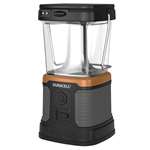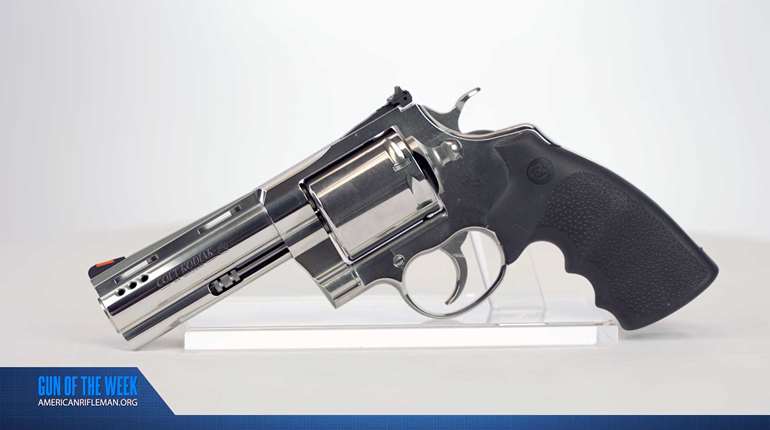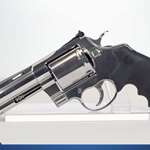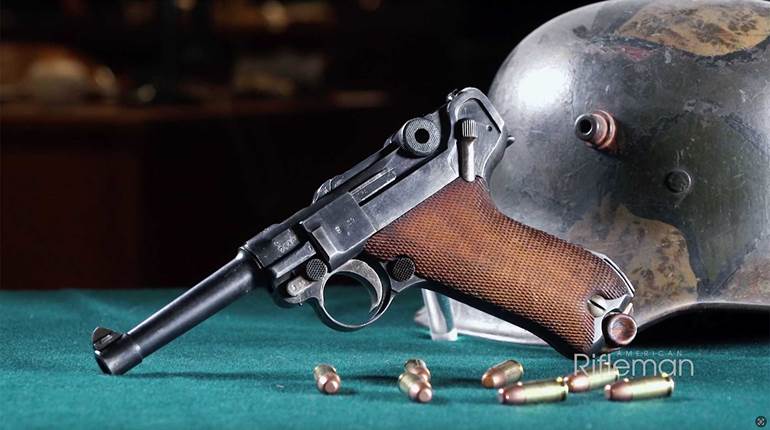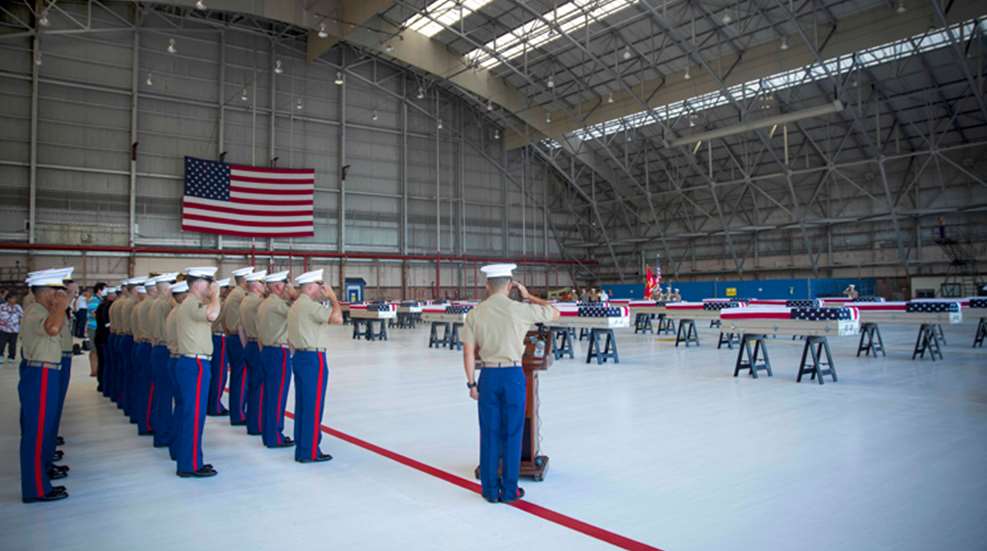
For 71 years, eight months, and six days they waited in an unmarked burial pit on a sliver of an island called Betio in what is now known as the Republic of Kiribati. All 36 of them, most of whom were rifleman from the 8th Marine Regiment, lost their lives during the first major battle of the Central Pacific Campaign: Operation GALVANIC—the opposed amphibious invasion of Tarawa in the former Gilbert Islands. For 76 hours during the third week of November 1943, the 2nd Marine Division clashed there with a Japanese garrison force of nearly 5,000 men under the command of Rear Admiral Keiji Shibazaki. 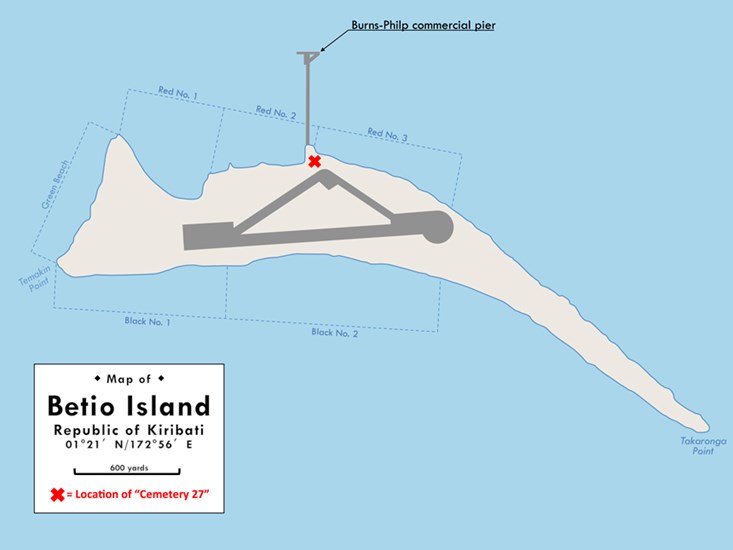
This map shows the location of “Cemetery 27” relative to some of Betio’s landmarks.
By the time the battle was over, more than 2,000 Americans had been wounded, and more than 1,000 were dead. The sheer number of bodies created an unforeseen challenge for the leadership of the Fifth Amphibious Corps, which had expected more modest casualties in the operation. A short-term solution was the temporary burial of the Marines and Sailors who fell during the battle in dispersed gravesites across the island. But even this stopgap measure required great exertion over the course of the next several weeks. As 1943 turned to 1944, the plan was that a graves registration unit would return for them all at some point in the not-too-distant future.
Since Operation GALVANIC was just the first step on the long road to Tokyo, the focus of the war turned elsewhere during the 20 months between the battle and the surrender in Tokyo Bay. Then in June 1946, the Army’s 604th Quartermaster Graves Registration Company came to Betio to recover the remains buried there, but that process quickly became an unexpectedly complicated one. During the two and a half year interval between the battle and the recovery operation, there had been a considerable amount of construction on the island and, as a result, U.S. Navy Seabees had graded almost every square inch of it. The men of the 604th found that most of the crosses indicating burial sites had no bodies beneath them, and they did not know where to begin looking because none among them had been involved in burying the dead back in 1943.
With no eyewitnesses to guide them to the island’s many unmarked mass graves, the recovery mission came up short—far short. All told, the 604th exhumed 495 bodies from various gravesites across the island, but the one designated Cemetery 27 could not be located. For three days they searched the area where the maps indicated this mass grave would be found, but there was nothing there. As a result, the 36 men buried in Cemetery 27 remained in it through the end of the 20th century and into the 21st. But they were not the only ones: In October 1949, an official Field Board declared almost 300 Americans from the Tarawa operation to be “KIA—body unrecoverable.” The men of Cemetery 27 represented just 12 percent of that total.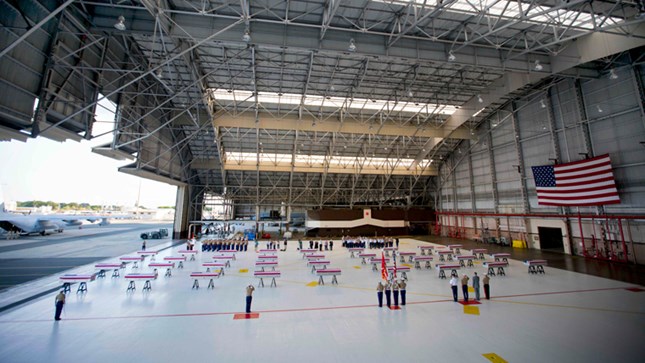
U.S. Marines from U.S. Marine Corps Forces, Pacific salute as "Taps" is played at the
end of a Dignified Transfer Ceremony on July 26, 2015 at Joint Base Pearl Harbor/Hickam.
During the ceremony, the remains of 36 men who fought and died in the Battle of Tarawa
during World War II were returned to American soil.
(U.S. Marine Corps photo by Sgt. William Holdaway) 406205-F-VGT04-791
Despite the fact that hundreds of supposedly “unrecoverable” bodies continued to rest in unmarked graves on Betio in the decades that followed the end of the war, construction workers on the island during that time periodically uncovered some of them. In 1974, a sewerage and fresh water project funded by the Australian government unintentionally dug-up the remains of five U.S. Marines with uniforms, equipment, helmets and dog tags. They also stumbled across a buried LVT with two sets of remains still in it. Three more men were discovered in 1980 and then two more in the year 2000. Over the years a total of 20 sets of American remains were accidentally disinterred on Betio, providing proof positive that the “unrecoverable” could actually be recovered.
These discoveries gave specific hope to the prospect that Cemetery 27 could yet be located and the 36 men in it finally brought home. There was a special compulsion driving the quest to locate this particular “cemetery” because it was known to be the final resting place of posthumous Medal of Honor recipient Alexander “Sandy” Bonnyman, Jr., a 33-year-old Marine officer who was killed while leading an attack on the final day of the battle.
The effort to find Cemetery 27 involved Bonnyman’s grandson, Clay Bonnyman Evans, and History Flight— an organization specializing in MIA search and recovery efforts. For 10 years they made regular visits to Betio, scouring the island with old maps, ground-penetrating radar, and eventually even a cadaver dog from California named Buster. These efforts finally paid off in May 2015 when Cemetery 27 was found and the remains in it exhumed. All 36 men were subsequently flown 2,400 miles from Kirabati to Joint Base Pearl Harbor/Hickam on Oahu and, upon arrival on July 26, 2015 a dignified ceremony transferred them to the Defense POW/MIA Accounting Agency—the government agency tasked with accounting for missing U.S. military personnel. One month later, the DPAA officially identified “Sandy” Bonnyman’s body, which was then announced by an official press release on Sept. 22, 2015.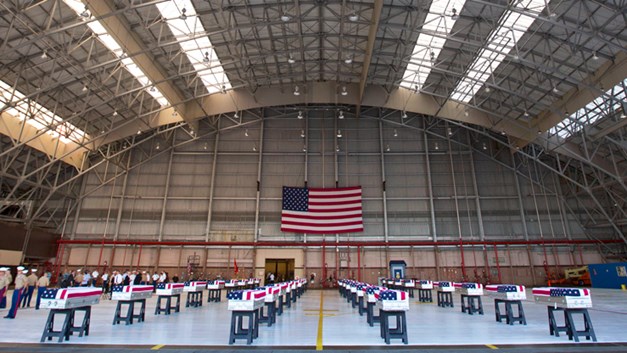
The remains of U.S. Marines who fell during World War II in the Battle of Tarawa rest in an aircraft hangar on Joint Base Pearl Harbor/Hickam after a transfer ceremony on July 26, 2015.
(U.S. Marine Corps photo by Sgt. William Holdaway) 319627-J-EHP21-674
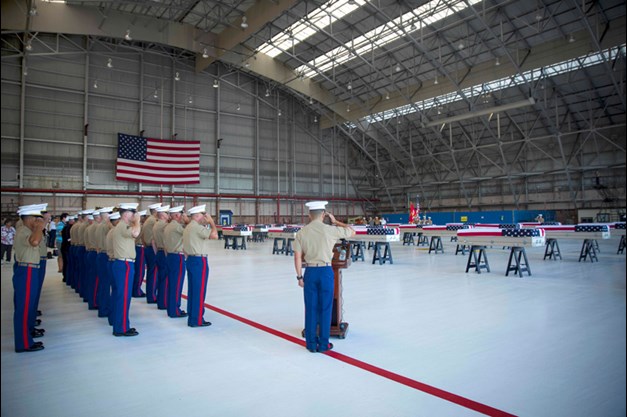
Marines salute as "Taps" is played at the end of a Dignified Transfer ceremony at Joint Base Pearl Harbor/Hickam, Hawaii, July 26, 2015. The ceremony honored the remains of 36 men killed in World War II during the Battle of Tarawa. 263103-O-MHH74-672 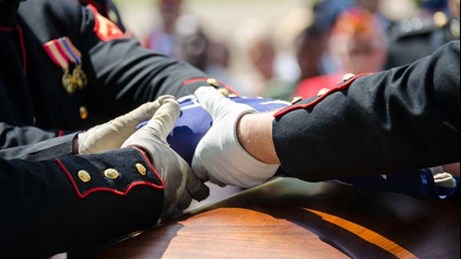
The following week Bonnyman was returned to his family for burial in Knoxville, Tenn., with full military honors. He was the first of the men from Cemetery 27 to be identified, and the DPAA has continued working through the group one at a time. To date, 28 of the 36 have been identified. With each new positive identification families are finally given a measure of closure—the kind that every family of the fallen needs, even after more than seven decades. (image by Jeremy Edward Shiok)
Additional reading:
Leave No Marine Behind: 1st Lt. Alexander Bonnyman Jr.
Tarawa













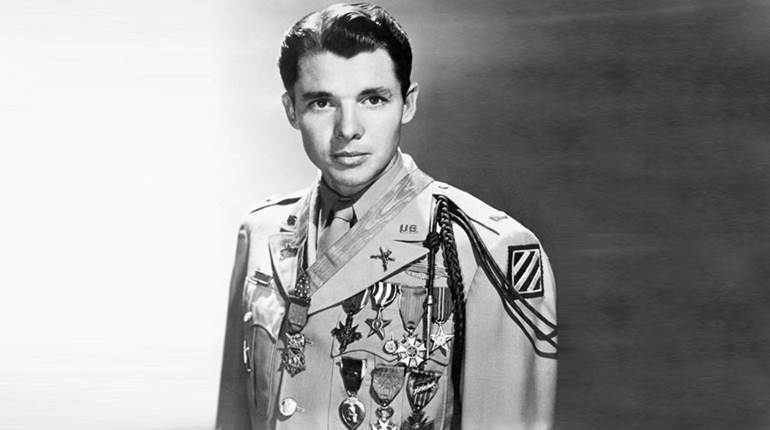
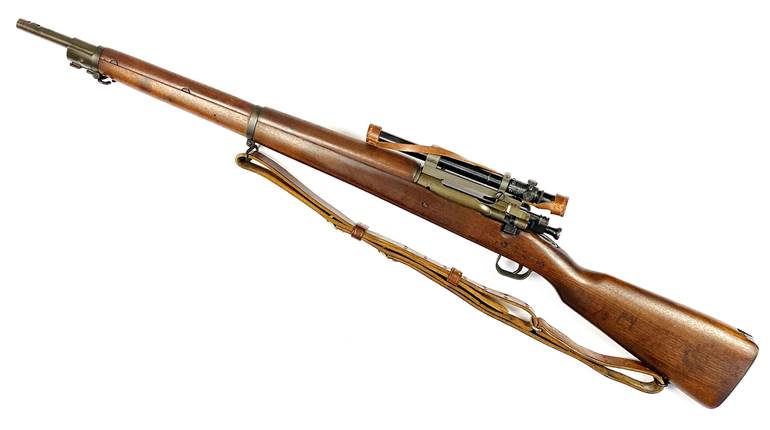

![Auto[47]](/media/121jogez/auto-47.jpg?anchor=center&mode=crop&width=770&height=430&rnd=134090788010670000&quality=60)





